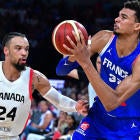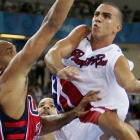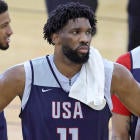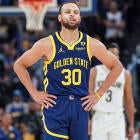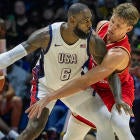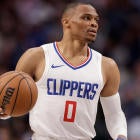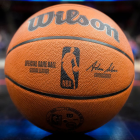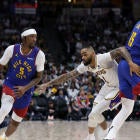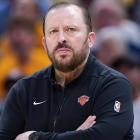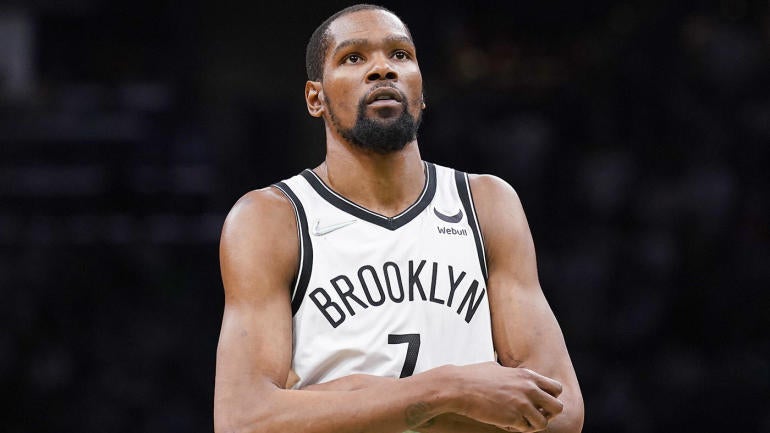
As the clock ticks, however slowly, down to what feels like an inevitable Kevin Durant trade, bear in mind that this isn't a simple case of Durant deciding where he wants to go and the Brooklyn Nets acquiescing. There are a lot of factors in play here. Below is a list of everything you need to know as Brooklyn considers what could be the highest-leverage trade in NBA history.
1. Durant is under contract until 2026
Most times when a player demands a trade, he is on a contract that is set to expire -- or like Anthony Davis in New Orleans, is about to enter his walk year. This leaves the team with little leverage. If it doesn't bend to the player's will and at least recoup market value, the player will soon be in position to simply leave on his own.
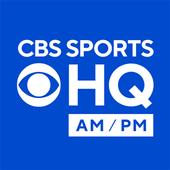
CBS Sports HQ Newsletter
Your Ultimate Guide to Every Day in Sports
We bring sports news that matters to your inbox, to help you stay informed and get a winning edge.
Thanks for signing up!
Keep an eye on your inbox.
Sorry!
There was an error processing your subscription.
That is not the case with Durant, who is about to enter the first year of the four-year, $193.6 million contract extension he signed with the Nets last summer. That means Durant is under contract with Brooklyn through 2026. So why would the Nets trade him if he can't threaten to walk on his own? Well, they don't have to. That's why they're saying they're prepared to take this as far as they need to in order to get the best deal possible. Part of that is posturing, and part of it is just true.
Brooklyn doesn't have to rush this, and it doesn't have to send Durant to the team of his choosing. Durant clearly owns a big portion of control here; the Nets are, after all, looking to trade him simply because he said that's what he wants. But to some degree, this will be on Brooklyn's terms.
Multiple reports indicate that the Nets asked the Timberwolves for a package including Anthony Edwards, Karl-Anthony Towns and four first-round draft picks in exchange for Durant. That's a ridiculous ask. Brooklyn knew it wouldn't get accepted and was simply looking to set as high a bar as possible.
This is what the 76ers did with Ben Simmons, who also demanded a trade from Philadelphia before the max extension he signed with the team even began. The Sixers waited that thing out, leaking similarly ridiculous asking prices while enduring the torturous process of Simmons refusing to play. Simmons made it as miserable as possible, but in the end, Philly had the power. Simmons wasn't going anywhere until the Sixers were happy with what came back. He was under contract for the next half decade. Get comfortable.
And in the end, it worked. The Sixers got what they wanted in James Harden. So whatever the Nets prefer, be it draft picks or All-Star player(s) or likely a combination of the two, they only have one shot to trade a player of this much value, and again, being that they hold the trump card of having Durant locked up through 2026, they're not going to concede much.
2. How Ben Simmons impacts potential trades
It's called the Designated Rookie rule, and it's best to let my colleague Sam Quinn, our CBA guru here at CBS Sports, explain how this rule, and Simmons' connection to it, impacts the players that Brooklyn can currently target in a potential Durant deal.
The Designated Rookie rule allows teams to sign players coming off rookie contracts to a five-year extension rather than the typical four. A team can designate up to two rookies for such contracts, but there's a caveat: only one of them can be acquired by trade. Ben Simmons, himself on a five-year Designated Rookie deal signed with Philadelphia, already occupies one of those slots for the Nets. Therefore, if the Nets keep Simmons, they cannot acquire another Designated Rookie player in a trade for Durant.
That takes 13 notable players off the table in a Durant trade for the time being:
- Luka Doncic, Mavericks
- Trae Young, Hawks
- Shai Gilgeous-Alexander, Clippers
- De'Aaron Fox, Kings
- Donovan Mitchell, Jazz
- Bam Adebayo, Heat
- Jayson Tatum, Celtics
- Karl-Anthony Towns, Timberwolves
- Devin Booker, Suns
- Jamal Murray, Nuggets
- Michael Porter Jr., Nuggets
- Andrew Wiggins, Warriors
- Joel Embiid, 76ers
You might remember the Celtics angling to trade for Anthony Davis, a Designated Rookie player, back in 2019, but they weren't able to do so with Kyrie Irving, another Designated Rookie acquired by trade, already on the roster. The only way Boston could've traded for Davis would've been to send Irving somewhere else.
The same workaround would be an option for the Nets, who could trade Simmons in a separate deal, or in a three-team setup, if they were in position to add one of the 13 players above for Durant. It's not an unrealistic scenario. Assuming Simmons intends to play basketball again, there would be plenty of suitors for him, and a three-team deal for Durant could be in the cards for other reasons.
Whatever the case, just keep this Designated Rookie rule in mind. There have been a lot of fake trades thrown out for guys like Bam Adebayo, Devin Booker and Trae Young. None of those guys, or anyone else on the list above, are eligible to be traded to Brooklyn as long as Simmons is still there.
3. Navigating the Stepien Rule
When the Timberwolves sent as part of their Rudy Gobert package four future first-round picks to the Jazz, the natural response was "holy cow, the Nets can get (insert huge number) picks for Durant!" That's not necessarily true. There's a limit. For starters, a team is only allowed to trade draft picks up to seven years into the future, meaning no picks beyond 2029 can currently be traded.
So can a team trade all seven of its picks through 2029? No. The Stepien Rule dictates that a team cannot be without a first-round pick in consecutive years. Put another way, unless a team has picks coming in via somewhere else from a previous trade, it can only trade its own pick every other year. Let's look at a few examples of teams that figure to be in the market for Durant.
Phoenix Suns: The Suns control all their own picks, but in a potential deal for Durant, they would only be allowed to trade -- in the every-other-year scenario -- a maximum of four: 2023, 2025, 2027 and 2029.
Toronto Raptors: Like Phoenix, the Raptors also control all their own future picks and could thus trade four future firsts: 2023, 2025, 2027 and 2029.
Miami Heat: Miami is another team that has been reported as a preferred Durant destination, and this gives us a chance to address the all-important protections that are so often attached to draft-pick compensation. It goes like this: The Heat owe their 2025 pick to the Thunder, but it's top-14 protected, meaning if it doesn't fall outside the top 14, it doesn't convey to OKC until 2026. The Stepien Rule doesn't allow for maybes.
Instead, the Heat have to design a trade package that fits within the Stepien Rule accounting for both possibilities. Say Miami trades its 2023 pick to the Nets for Durant, that rules out 2024 in the every-other-year scenario. Then, being that the pick they owe to OKC could convey in either 2025 or 2026, that wipes out both those years plus 2027 (in the event that it conveys in 2026).
- There are a few workarounds as it pertains to protections and the Stepien Rule. It's a bit complicated, as is pretty much everything CBA related. Again, I'll refer to Quinn's explanation.
The first workaround would be removing the protections from an owed pick, which is not only risky, but requires the consent of the team that owns that pick. The second is by trading picks without a designated year. Typically, the way this works is for the trading team to agree to send out a first-round pick two years after the original pick or picks that it owes elsewhere convey. Put more simply, it essentially means agreeing in advance to give up their next allowable pick even if they don't technically know when that pick will come.
The downside risk here is that if the protections on those previously owed picks prevent them from conveying long enough, the acquiring team can be left with nothing. This notably occurred in 2017. At the time, the Lakers owed two future first-round picks, the second of which was meant for Orlando. The problem was that the first was top-three protected … but came in at No. 2 overall three years in a row. The Orlando pick therefore expired because it would have needed to convey more than seven years after the original deal.
That caveat withstanding, if Miami was to trade its 2023 pick, the next pick it would be allowed to attach to a trade would be 2028. If it did that, 2029 would then be ruled out. Long story short, Miami can trade a maximum of two future first-round picks to Brooklyn for Durant: 2023 and either 2028 or 2029 -- unless Brooklyn is willing to accept the "next allowable" provision detailed above, in which case the Heat could trade 2023 and the next two allowable, which would be 2027 and 2029 if the pick they owe OKC conveys in 2025.
That would be a big IF for Brooklyn. If that pick doesn't convey until 2026, then the Nets would be stuck with the 2023 and 2028 picks with the third first-rounder it thought it was getting turning into a second-rounder. The only way I see this happening is if the Heat remove the protections from the OKC pick, ensuring it goes out in 2025, clarifying Miami's outgoing pick allowance at three.
That's a lot of moving parts when you consider the Heat would almost certainly also have to trade Adebayo to get Durant, which would force the Nets (remember the designated rookie rule!) to also move off Ben Simmons.
New Orleans Pelicans: New Orleans is loaded with draft capital and could, if it desired, trade a maximum of six first-round picks for Durant. This is because in addition to their own picks, the Pelicans have picks coming in from the Lakers (via the Anthony Davis deal) and the Bucks (via the Jrue Holiday deal).
Example: New Orleans trades its 2023 pick to Brooklyn (which could be its pick or the Lakers' pick, whichever is higher). Typically, that would rule out trading their 2024 pick, but the Pelicans also have the Lakers' pick in 2024 (with the right to defer to 2025), so it could trade the Lakers' pick and still be left with their own to satisfy the Stepien Rule.
So now that's 2023 and 2024 going out. Since they still have their pick in 2024 (remember, they had two to work with), they can trade the 2025 pick as long as they hang onto their 2026 pick. So that's 2023, 2024 and 2025 going out. Then they can trade their own and the Bucks' pick (from the Holiday trade) in 2027, making for five total picks. Then keep their own in 2028, and trade their 2029 pick for a total of six future picks eligible for trade. Unless the Thunder get involved, no team can trade more draft capital for Durant than New Orleans.
4. The Houston Rockets factor
Being that the Nets owe the Rockets their 2024 and 2026 first-round picks from the James Harden trade (with Houston also having the right to swap picks with the Nets in 2023, 2025 and 2027), Brooklyn doesn't have much incentive to go into tank mode. If the Nets lose, it's the Rockets who will get the high draft pick. That's why you're hearing that the Nets want All-Star player(s) in return. They intend to remain competitive with a short pathway to the next era of contention.
That said, there is one possible way the Nets could have their tank and eat it too. Being that the 2023 pick owed to Houston is a swap (meaning Houston gets the higher of the two picks), and being that Houston is a good bet to finish with a pretty bad record in its own right, the Nets could, in theory, tank their way into a high lottery pick, and the worst that would happen is they would switch picks with Houston. As long as Houston is also drafting high, the Nets would still get a high pick in a talented draft class.
Example: The Nets tank all the way to a top-three pick. Houston lands at No. 4 or 5 or 6. They swap. Yeah, Brooklyn loses a top-three pick, but it still lands a great pick. Combine that with a the bevy of picks it could get for Durant and Irving, and suddenly that's a huge package of picks it could then go out and flip for, say, Donovan Mitchell (as long as they move off Simmons; remember the Designated Rookie rule!) or whatever other star is looking to get out of his current situation.
Brooklyn would really be threading a needle here. But it's a legitimate route to tank one year and then have a stable of draft picks to turn yourself right back into a contender in a year's time. My guess is Brooklyn won't do it. The Nets will end up with a couple good players to remain competitive in the short term and still enough draft picks to get into future disgruntled-star bidding.
Either way, the takeaway here is that Brooklyn cannot simply cash in its stars for future draft equity (like Oklahoma City did with Paul George and Chris Paul and Russell Westbrook) with a single-minded intention of tanking. The Rockets are in the way. Starting in 2024, the Nets have every reason to put a winning team on the floor.
From Houston's perspective, however, tank away! Just for fun, imagine if the Nets and Rockets were to end up with two of the worst three records next season. They would each have a 14 percent chance of getting the No. 1 pick, meaning Houston, with the right to swap picks with Brooklyn, would actually double its chances of lucking into Victor Wembanyama (a drool-inducing prospect) to 28 percent.










